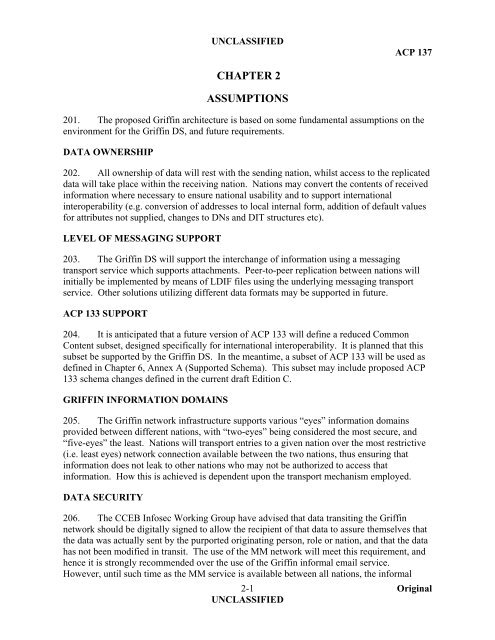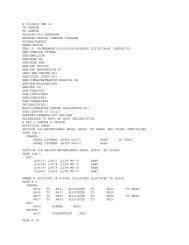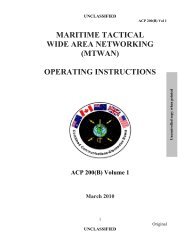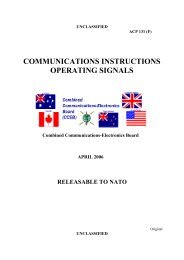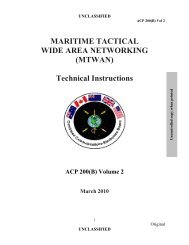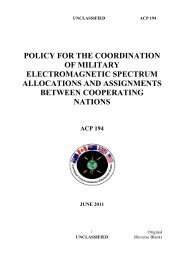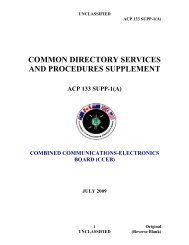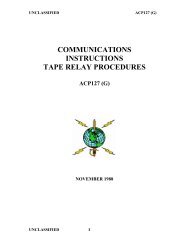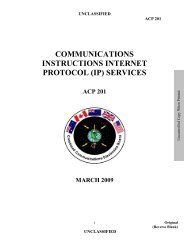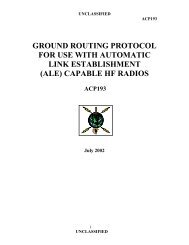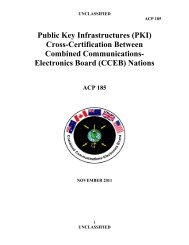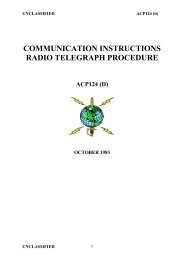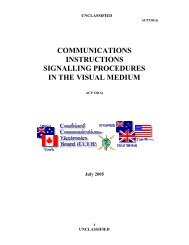ACP 137
ACP 137
ACP 137
Create successful ePaper yourself
Turn your PDF publications into a flip-book with our unique Google optimized e-Paper software.
UNCLASSIFIED<br />
<strong>ACP</strong> <strong>137</strong><br />
CHAPTER 2<br />
ASSUMPTIONS<br />
201. The proposed Griffin architecture is based on some fundamental assumptions on the<br />
environment for the Griffin DS, and future requirements.<br />
DATA OWNERSHIP<br />
202. All ownership of data will rest with the sending nation, whilst access to the replicated<br />
data will take place within the receiving nation. Nations may convert the contents of received<br />
information where necessary to ensure national usability and to support international<br />
interoperability (e.g. conversion of addresses to local internal form, addition of default values<br />
for attributes not supplied, changes to DNs and DIT structures etc).<br />
LEVEL OF MESSAGING SUPPORT<br />
203. The Griffin DS will support the interchange of information using a messaging<br />
transport service which supports attachments. Peer-to-peer replication between nations will<br />
initially be implemented by means of LDIF files using the underlying messaging transport<br />
service. Other solutions utilizing different data formats may be supported in future.<br />
<strong>ACP</strong> 133 SUPPORT<br />
204. It is anticipated that a future version of <strong>ACP</strong> 133 will define a reduced Common<br />
Content subset, designed specifically for international interoperability. It is planned that this<br />
subset be supported by the Griffin DS. In the meantime, a subset of <strong>ACP</strong> 133 will be used as<br />
defined in Chapter 6, Annex A (Supported Schema). This subset may include proposed <strong>ACP</strong><br />
133 schema changes defined in the current draft Edition C.<br />
GRIFFIN INFORMATION DOMAINS<br />
205. The Griffin network infrastructure supports various “eyes” information domains<br />
provided between different nations, with “two-eyes” being considered the most secure, and<br />
“five-eyes” the least. Nations will transport entries to a given nation over the most restrictive<br />
(i.e. least eyes) network connection available between the two nations, thus ensuring that<br />
information does not leak to other nations who may not be authorized to access that<br />
information. How this is achieved is dependent upon the transport mechanism employed.<br />
DATA SECURITY<br />
206. The CCEB Infosec Working Group have advised that data transiting the Griffin<br />
network should be digitally signed to allow the recipient of that data to assure themselves that<br />
the data was actually sent by the purported originating person, role or nation, and that the data<br />
has not been modified in transit. The use of the MM network will meet this requirement, and<br />
hence it is strongly recommended over the use of the Griffin informal email service.<br />
However, until such time as the MM service is available between all nations, the informal<br />
2-1<br />
Original<br />
UNCLASSIFIED


